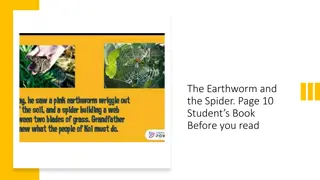Understanding Calcium Influence on Earthworm Behavior in Forest Ecosystems
Earthworm biomass dominance by Lumbricus terrestris in the Siemianice Experimental Forest is linked to their high calcium requirements, as indicated by their calciferous glands producing calcium carbonate to regulate blood pH in the face of high soil CO2 levels. The positive relationship between forest floor removal and litter calcium likely supports the nutritional needs of earthworms, impacting decomposition rates in forest ecosystems.
Download Presentation

Please find below an Image/Link to download the presentation.
The content on the website is provided AS IS for your information and personal use only. It may not be sold, licensed, or shared on other websites without obtaining consent from the author. Download presentation by click this link. If you encounter any issues during the download, it is possible that the publisher has removed the file from their server.
E N D
Presentation Transcript
Synthetic Writing 5-minute workshop
From Hobbie et al. 2006: Whether earthworms in this site are responding directly to higher litter Ca or to the concomitant higher concentrations of soil Ca (Reich et al. 2005) is unknown (Ponge et al. 1999). Regardless, the positive relationship between forest floor removal and litter Ca likely arises from the nutritional requirements of the earthworms at the site. Although there are several species of earthworms in the Siemianice Experimental Forest (Reich et al. 2005), earthworm biomass is dominated by Lumbricus terrestris (C. M. Hale, unpublished data). Lumbricus is an anecic species that makes deep burrows, but consumes litter on the soil surface. Lumbricus has well-developed calciferous glands that produce calcium carbonate (Robertson 1936, Canti and Piearce 2003). It has been suggested that Lumbricus and other species with well-developed calciferous glands produce calcium carbonate to reduce their blood CO2 levels and regulate blood pH when faced with high soil CO2 levels, and thus they have a high Ca requirement (Crang et al. 1968, Robertson 1936, Piearce 1972b).
What is the topic of this paragraph? What is the conclusion?
Which of the following results would enhance this paragraph? Why? (1) Holdsworth et al. (2008) found that decomposition of oak litter, a species with Ca-poor litter, was unaffected by earthworm abundance, while decomposition of basswood, a species with Ca- rich litter, was accelerated by earthworms. (2) Silver and Miya (2001) reviewed as many studies of root decomposition as they could find, and found that across multiple studies, root Ca concentration was positively related to root decomposition rates. (3) In a study that manipulated grassland biodiversity, higher earthworm densities accelerated the decomposition of nitrogen-rich legume litter (Milcu et al. 2008).
References Hobbie, S. E., P. B. Reich, J. Oleksyn, M. Ogdahl, R. Zytkowiak, C. M. Hale, and P. Karolewski. 2006. Tree species effects on decomposition and forest floor dynamics in a common garden. Ecology 87:2288-2297. Holdsworth, A. R., L. E. Frelich, and P. B. Reich. 2008. Litter decomposition in earthworm-invaded northern hardwood forests: Role of invasion degree and litter chemistry. Ecoscience 15:536- 544. Milcu, A., S. Partsch, C. Scherber, W. W. Weisser, and S. Scheu. 2008. Earthworms and legumes control litter decomposition in a plant diversity gradient. Ecology 89:1872-1882. Silver, W. L. and R. K. Miya. 2001. Global patterns in root decomposition: comparisons of climate and litter quality effects. Oecologia 129:407-419.
From Lane et al. 2010: Apart from being counter-intuitive, the most remarkable feature of chemiosmosis is how universal, how fundamental, proton gradients are across all of life. Mitchell appreciated that proton gradients frequently power active transport in bacteria, along with the rotating motor of the bacterial flagellum; and they are as central to ATP synthesis in photosynthesis as they are to oxidative phosphorylation in mitochondria or bacteria.(51) The fact that a proton-motive force powers chloroplasts, mitochondria and bacteria is already a startlingly diverse heritage; but we now know that proton gradients are ubiquitous in archaea as well as bacteria. Both archaea and bacteria generate proton gradients across their plasma membranes; both synthesise ATP via oxidative phosphorylation; both share similar membrane-bound rotor-stator-type ATP synthase enzymes, albeit with a few minor differences (the bacterial F-type and archaeal A-type ATPases share a number of unquestionably homologous subunits, as well as others apparently unrelated).(52)) Thus the deep and broad phylogenetic distribution of chemiosmosis is precisely the opposite of that of fermentation. Just as we can say that LUCA had a ribosome, which will not startle anyone, we can say that LUCA obtained energy by chemiosmotic coupling.
Which of the following results would enhance this paragraph? Why? (1) Bacteria and archaea differ markedly in the gene sequences and crystal structures of enzymes that catalyse the individual steps of fermentation (Siebers & Schonheit 2005). (2) Both archaea and bacteria conduct electrons and pump protons using ferredoxins, quinones and cytochromes that are closely related in chemical structure (Baymann et al. 2003). (3) Bada (2004) asserts that RNA was once the only catalyst as well as the only replicator and so all the basic chemistry of life was invented by RNA.
References Bada JL. 2004. How life began on earth: a status report. Earth Planet Science Letters 226: 1 15.4. Baymann F, Lebrun E, Brugna M, et al. 2003. The redox protein construction kit: pre-last universal common ancestor evolution of energy conserving enzymes. Philosophical Transactions of the Royal Society of London B 358: 267-74. Lane, N, J.F. Allen, & W. Martin. 2010. How did LUCA make a living? Chemiosmosis in the origin of life. BioEssays 32:271-280. Siebers B, Schonheit P. 2005. Unusual pathways and enzymes of central carbohydrate metabolism in Archaea. Current Opinions in Microbiology 8:695 705.13.























